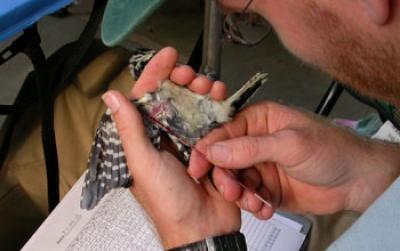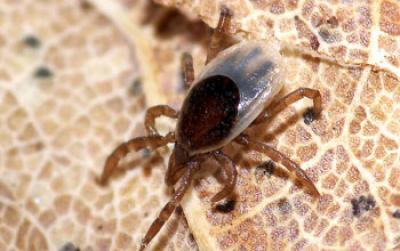West Nile virus, Lyme disease and hantavirus. All are infectious diseases spreading in animals and in people. Is human interaction with the environment somehow responsible for the increase in these diseases?
The ecology and evolution of infectious diseases will be highlighted at two symposia at the Ecological Society of America's annual meeting, held from Aug. 5-9 in Minneapolis, Minn.
One symposium will address human influences on viral and bacterial diseases through alteration of landscapes and ecological processes.
Another will focus on the emerging field of eco-epidemiology, which seeks to integrate biomedical and ecological research approaches to addressing human health threats.

Is there a connection between birds and West Nile virus? A gray catbird caught in a research mistnet may tell.
(Photo Credit: Marm Kilpatrick)
Much of the research presented is funded by the joint National Science Foundation- (NSF) National Institutes of Health Ecology and Evolution of Infectious Diseases (EEID) Program.
"These sessions show that basic research is critical for managing disease threats," said Sam Scheiner, NSF EEID program director. "They also showcase the need to link scientists with public health professionals."
The first symposium, on Monday, Aug. 5, will take a deeper look at the connections between human activities and infectious diseases.
Though we often think of diseases as simply being "out there" in the environment, human actions--such as feeding birds--can influence the abundance, diversity and distribution of wildlife species and thus, infectious diseases.
"New human settlements, the spread of agriculture and the increasing proximity of people, their pets and livestock to wild animals increase the probability of disease outbreaks," said session organizer Courtney Coon of the University of South Florida.

This image shows scientist Marm Kilpatrick taking a blood sample from a downy woodpecker.
(Photo Credit: UCSC)
"We're interested in learning more about how urban and other environments that humans dramatically change affect the susceptibility and transmission potential of animals that are hosts or vectors of disease."
What are the key determinants of spillover of wildlife diseases to domestic animals and humans?
Why is the prevalence of pathogens in wildlife in urban areas often altered by counterparts in less developed environments?
Speakers will address these and other questions.
The second symposium, on Tuesday, Aug. 6, will continue the theme of infectious diseases, but with an eye toward integrating biomedical and ecological approaches into the investigation and control of emerging diseases.
"Environmental processes and human health are linked, and we'd like to chart a future in which ecologists and epidemiologists more routinely work in tandem to address health problems," said symposium organizer Jory Brinkerhoff of the University of Richmond.
Scientists studying human diseases may overlook possible ecological factors.
For example, most Lyme disease cases in the eastern United States happen in the North even though the black-legged tick, which transmits the bacterium, is found throughout the Eastern states.
Human life histories and interactions with the environment, researchers say, are critically important to the success of managing a mosquito-borne virus called dengue fever.
"Disease ecologists and epidemiologists address some of the same kinds of questions, yet operate largely in isolation of one another," said Brinkerhoff.
"We're bringing them together to share their approaches and study designs, and to strengthen our ability to address public health issues."

This image shows a nymphal blacklegged tick on leaf litter in Tennessee.
(Photo Credit: Graham Hickling)
Source: National Science Foundation